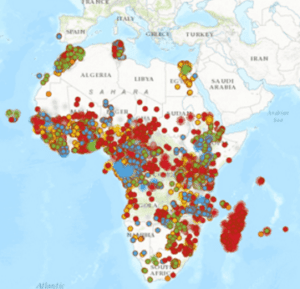 The African Development Bank (AfBD) has released a new online tool that allows anyone in the world to see at a glance how the Bank’s projects are progressing and performing.
The African Development Bank (AfBD) has released a new online tool that allows anyone in the world to see at a glance how the Bank’s projects are progressing and performing.
MapAfrica 2.0 is an interactive online portal that shows where the AfDB is making an impact on the continent and how 800 of the Bank’s projects relate to its “High 5” development priorities: light up and power Africa, feed Africa, industrialise Africa, integrate Africa, and improve the quality of life for the African people.
As well as making the Bank’s work visible to a global audience, the portal will give the Bank’s stakeholders a better understanding of how its activities contribute to local development, as well as help to ensure that the AfDB allocates its resources to greatest effect.
MapAfrica 2.0, which updates the first version of the portal, was launched on 30 June in Abidjan, Côte d’Ivoire, during the second meeting of the Fourteenth Replenishment of the African Development Fund (ADF-14), as part of the Results Measurement Framework presentation.
Unveiling the platform, Simon Mizrahi, Director of the AfDB’s Quality Control and Results Department, said, “This dynamic tool enables the Bank to provide transparent and equal access to its work across Africa. It is an effort to showcase our results and to track our projects on the ground.”
With MapAfrica, developed by the Bank in partnership with the information agency Development Gateway, web users can track the Bank’s projects throughout Africa, zooming in on a region or country and browsing the icons corresponding to the Bank’s “High 5” priorities.
“MapAfrica allows the AfDB to present its investments and results in a simple and more intuitive way, bringing the institution closer to the people they serve,” said Jean-Louis Sarbib, the CEO of Development Gateway.
Donors provide billions of dollars in development assistance every year, but tracking the results has been challenging without information on individual development aid activities.
Results stories have been developed to present detailed accounts of some completed projects. These supply details about the beneficiaries of the project, the approach taken, the main results and the lessons learned.
In the future, the AfDB aims to use the tool to improve the planning of its projects on the ground and to understand where development gaps lie.
 The African Development Bank (AfBD) has released a new online tool that allows anyone in the world to see at a glance how the Bank’s projects are progressing and performing.
The African Development Bank (AfBD) has released a new online tool that allows anyone in the world to see at a glance how the Bank’s projects are progressing and performing.






